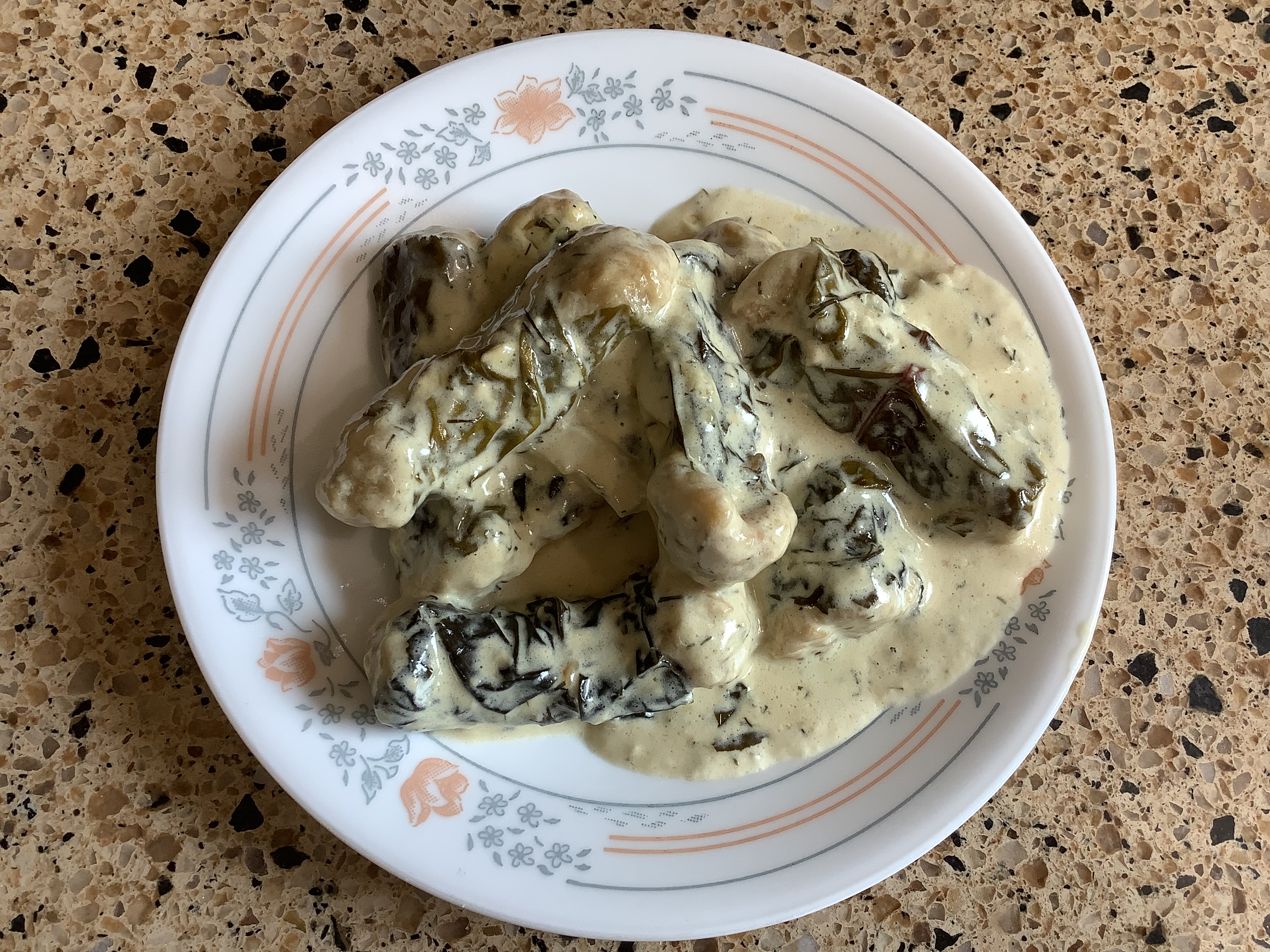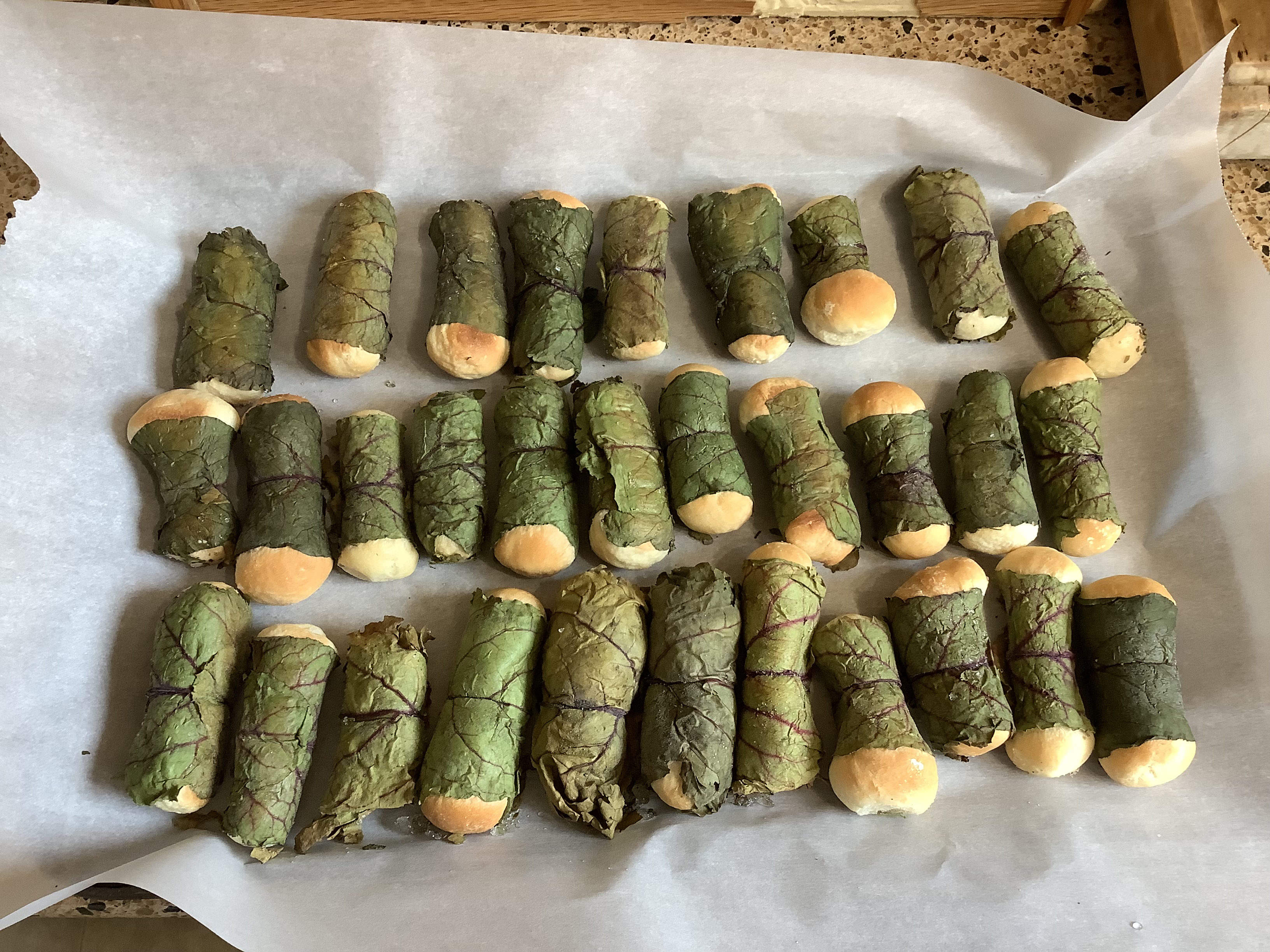
Beetniks
Ukrainian beet leaves stuffed with bread dough and topped with dill and onion sauce

This Ukrainian dish is not as familiar as borscht, perogies or cabbage rolls but beetniks are simply delicious. Beetniks are little pieces of bread dough wrapped in a beet leaf which are baked and then covered or cooked in a creamy onion and dill sauce.
This dish was born out of necessity in using what many households had from their gardens. Many farmers grow wheat in Ukraine and it is known as the bread basket of Europe. Therefore, it stands to reason that many traditions and dishes hold bread with utmost importance and respect.
Some call them beet leaf Holuptsi which are like beet leaf cabbage rolls. Beetniks are somewhat tedious to make but well worth the effort.
DOUGH
1 Tablespoon white sugar
1 teaspoon salt
1 tablespoon olive or canola oil
¾ cup warm water
1 package of fast rising yeast
2 cups all purpose flour (I prefer bread dough flour)
BEETS
About 24-30 washed and patted dry beet leaves that have been wilted.
I pick and wash my beet leaves the day before I plan on making this dish. Pat the leaves dry and place them on cookie sheets lined with paper towel and leave them overnight to wilt and dry. Cut off any of the stems as they make rolling the dough in the leaf a bit harder.
You can wash, pat dry and freeze the leaves, just place them stacked in a Ziploc in 2 layers. When you are ready to use them, just thaw them at room temperature, remove them from the bag and pat them dry. They are now ready to be used.
CREAMY ONION AND DILL SAUCE
Whip cream or ½ and ½, enough to cover your baked buns
1 chopped medium onion
About ¼ cup fresh or frozen chopped dill (add more if you like)
¼-1/2 teaspoon salt (depending on your taste)
¼ teaspoon pepper
STEP 1
Place the sugar, salt, oil, water and yeast into a bowl of a stand mixer and mix on low for about 1 minute with the paddle attachment. Add the flour, one cup at a time until it forms a ball that is smooth and slightly sticky to touch, then switch to the dough hook attachment and let it knead the dough for about 2 minutes. If doing the dough by hand, place the ingredients into a large bowl in the same order as above but then once you add the flour, mix it well with your hands until it no longer sticks to your hands. You may need to add a bit more flour if it is too sticky to handle. Cover the dough with a tea towel and let it rise in a warm place for about 1 hour. I just place my dough in the oven and turn the oven light on. The heat from the oven light warms the oven slightly but doesn't get too hot.
STEP 2
Line 2 baking sheets with parchment paper.
STEP 3
Once the dough has doubled in size, punch it down and leave it in the bowl.
Step 4
Take a beet leaf and place it on a cutting board or counter. Cut a piece of dough that is a bit smaller than the width of the beet leaf and wrap the leaf loosely around the dough. As the dough rises, it will come out the sides of your leaf. Wrap the leaf loosely around the dough and place the seam side down on the cookie sheet, making sure the leaf is secure around the dough. The leaf ends should overlap as well, covering all the dough. Place the little rolls about 2 inches apart on our cookie sheet so they have room to rise but not touch each other. Once your cookie sheets are full, cover the rolls with a clean tea towel and let them rise in a warm place until the dough rises out the sides of the leaves, about 45 minutes or so.
STEP 5
Preheat oven to 350 degrees and bake for about 20-25 minutes until they are golden brown. Remove from the oven and place the buns on cooling racks.
Step 6
To cook your buns, place the buns in a large roaster or casserole dish that you have greased with butter or margarine (this is not a low-calorie dish!), placing the buns side by side. I do one layer, add a few chopped onions then pour 1/3 of the cream and dill mixture of top and repeat this for 2 more layers making sure you have at least 3 inches at the top of your roaster or dish as the buns will expand as they cook. Make sure you have enough of the cream mixture so that the buns are slightly covered. Cover and cook at 300 degrees for about 1 or 1 1/2 hours or until the sauce has thickened. Avoid the temptation to cook them at a higher temperature as the cream will run over. I've also done these in my slow cooker, my preferred method in the summertime. I just filled half my slow cooker with the buns, placed my onions on top, poured the whip cream that I mixed the dill, salt and pepper into and gently mix this all up. I cook this on low for about 3 hours, stirring gently about 3 times until the sauce has thickened.
You can freeze the baked buns in Ziploc bags for up to 3 months. Thaw them before adding them to the casserole dish or slow cooker.
You can also cook the sauce on the stove until it is thickened and pour it over some warmed buns.
Serve with cooked ham or sausage or by themselves. I rarely have any left over!
Marlene Pratt

